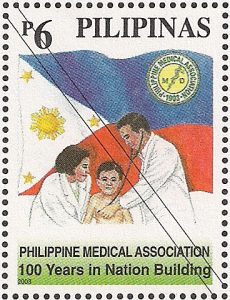Trivia about the Philippine Medical Association
2003 is a historic year for the Philippine Medical Association (PMA), as it observes its 100th Anniversary. The PMA, the umbrella organization of the medical profession of the country, is a non-profit organization under the Philippine laws. It has been formed mainly to bring together the entire medical profession under one roof, and to serve as an authoritative source of information on health, disease, and medical practice. It is also the national organization committed to national healthcare delivery for the promotion of health and the prolongation of life of the people.
One hundred years ago, on September 15, 1903, the Philippine Medical Association was founded. The establishment of the PMA was actually an offshoot of the need of the Manila Medical Society, founded a year earlier, to make its activities and usefulness more extensive. To do so, it was largely felt that to affiliate with the American Medical Association (AMA) would greatly enhance its prestige and influence. However, the AMA rejected its application for affiliation on the ground that the formation of a national medical association was a prerequisite for the Manila Medical Society to affiliate. Hence, the Philippine Island Medical Association was founded and subsequently affiliated with the AMA.
The first group of officers elected were Dr. Joseph M. Donelan as President; Dr. T. H. Pardo de Tavera and Dr. Jose Albert as Vice Presidents, with Dr. William E. Musgrave as Secretary General. That year saw the start of American role in the fledgling years of the PMA. The last American presldent of the association was Dr. H. H. Steinmetz during the years 1921-1922.
On July 4, 1946, the independence of the Philippines from U.S. colonial rule saw the breaking of the affiliation of the Philippine Island Medical Association with the American Medical Association. Thenceforth, the association became known as the Philippine Medical Association.
Even as early as 1927, the role of the PMA in healthcare was given recognition by government. This was evident in the appointment of members to the Board of Medical Examiners. In 1927, the Secretary of Interior, upon the instruction of the Governor-General, consulted with the PMA and requested a list of eligibles for appointment to the Board. From then on, the government department made it a policy to consult the national medical organization whenever a vacancy existed.
In 1929, through the initiative of the Board of Medical Examiners and the active participation of the PMA, an amendment of the Medical Act (Act No.3609) was passed in the Legislature. It prohibited foreigners from practicing medicine in the Philippines unless their own countries allowed their Filipino counterparts to practice there.
In 1930, the Code of Ethics Commission was appointed to prepare a Code of Medical Ethics especially adapted to the needs of the medical profession in the Philippines.
On June 2, 1936, the PMA initiated the groundwork to upgrade the national Committee on Health into a full-blown Department of Health and Welfare. The association was also largely responsible for the establishment of the state school of medicine of the University of the Philippines, as well as the Philippine General Hospital and the Government Health Insurance Program, in response to the urgent call to address the health needs of the poor.
To study the claims of manufacturers on the safety and efficacy of pharmaceutical preparations, the PMA proposed the creation of the Food and Drug and Cosmetic Board, the forerunner of the Bureau of Foods and Drugs.
The PMA co-founded regional medical organizations to promote development and improvement of healthcare delivery system in the region. These are the Confederation of Medical Associations in Asia and Oceania (CMAAO), the Federation of Tropical Medicine (FTM), and the Medical Associations of South East Asian Nations (MASEAN).
The PMA continues to help solve problems of maldistribution of health providers. It launched and continues to support the project, the Medical Assistance to Rural Indigent Areas (MARIA) to help settle physicians in doctorless areas of the country. The San Juan Project also provides encouragement for specialists to serve rural and far flung areas. The People’s Adoption of Total Health Self-Sufficiency (PATHS) program to encourage local component societies and doctors to provide clinic facilities and manpower to serve people in depressed areas.
The voice of the PMA fearlessly rings and provides direction in health legislation as much as it provides leadership in time of crises, unrest, turmoil, disorder, disasters and calamities to guide the people. Medical missions and disaster relief operations are standard public service in time of epidemics, man made and natural calamities.
In recognition of its humanitarian mission and outstanding performance in the healthcare delivery of the country through the years, the PMA has been cited and conferred the most prestigious award conferred by the Professional Regulation Commission, the “Most Outstanding Accredited Professional Organization Award.”

Recent Comments